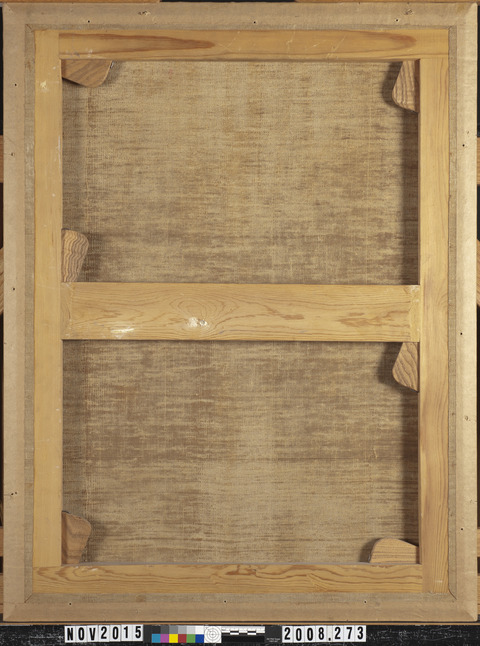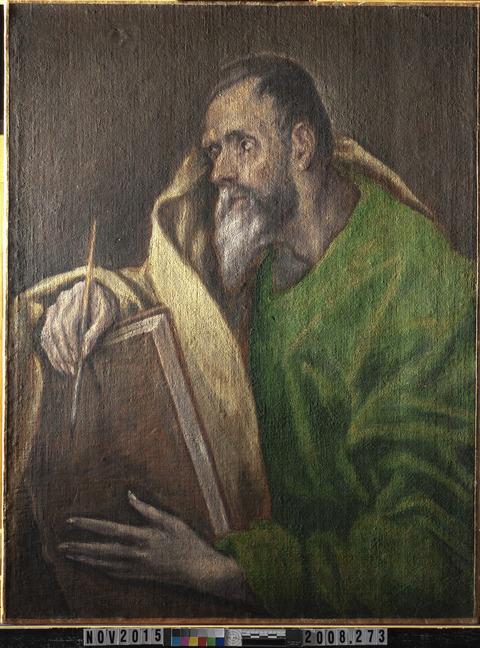Overview
Accession number: 2008.273
Artist: El Greco (Doménikos Theotokópoulos) and Workshop
Title: St. Luke
Materials: Oil (untested) on canvas
Date of creation: About 1610–1614
Previous number/accession number: C10034
Dimensions: 81.5 x 55 cm
Conservator/examiner: Fiona Beckett
Examination completed: 2016
Distinguishing Marks
Front:
Item 1. Painted initials “ẟθ” near proper left hand of the sitter (tech. fig. 1).
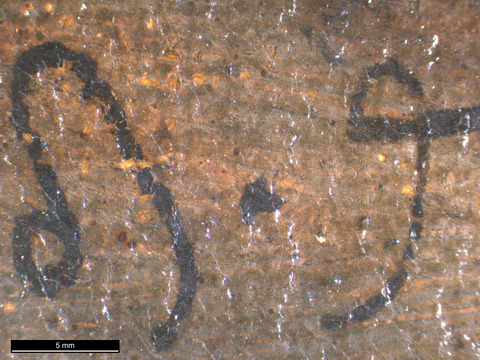
Back:
None
Summary of Treatment History
Letters between G.H.A. Clowes and the Newhouse Galleries, as well as the Fernando Álvarez de Sotomayor, the director of the Prado, reveal information about the conservation history of the painting before the works arrived at the IMA on long term loan in 1971. A letter from Álvarez de Sotomayor to Clowes states that the paintings were brought to the Prado where they were cleaned and relined before 1946.1
The painting was treated by Edward O. Korany in June 1952 for B.M. Newhouse before being purchased by Dr. Clowes. The treatment included cleaning, as referenced in a letter from Korany to Newhouse dated 20 December 1952.2 In a letter from Newhouse to Clowes, Newhouse states, “Despite the fact that these pictures require nothing but cleaning, it must be done very carefully and slowly and the man who is doing it can’t be hurried. If one attempts to hurry him it makes it all the worse and nothing is accomplished.” Newhouse offered to bring the paintings to Woods Hole for Clowes to see while he was visiting Easterly.3 It appears that he did just this because, in a letter from the following September, Newhouse tells Clowes that the paintings were sent back for a final varnishing due to blooming, “which generally happens if you take them away before the final coat of varnish has been applied."4 By October, Clyde Newhouse wrote to Clowes to confirm that the treatment on the El Grecos was finished and that the varnish looked magnificent.5
Documentation indicates a series of condition assessments and treatments were carried out on the collection at about the time the works were moved from the Clowes residence to the IMA in 1971. A condition report by Paul Spheeris in October of that year, likely carried out before the paintings were relocated, described the painting as having a chipped frame but that the painting was “O.K.” He recommended cleaning the work for the sake of its appearance but not for the safety of the painting.6 A second condition assessment was carried out upon arrival of the paintings at the IMA. This assessment describes the work as being in good condition and no work was deemed necessary.7
The painting was previously examined and documented in the Clowes Collection annual survey from 2011 to 2018.
Current Condition Summary
Aesthetically and structurally, the painting is in good condition and suitable for display.
Methods of Examination, Imaging, and Analysis
| Examination/Imaging | Analysis (no sample required) | Analysis (sample required) |
|---|---|---|
| Unaided eye | Dendrochronology | Microchemical analysis |
| Optical microscopy | Wood identification | Fiber ID |
| Incident light | Microchemical analysis | Cross-section sampling |
| Raking light | Thread count analysis | Dispersed pigment sample |
| Reflected/specular light | X-ray fluorescence spectroscopy (XRF) | Fourier-transform infrared spectroscopy (FTIR) |
| Transmitted light | Macro X-ray fluorescence scanning (MA-XRF) | Raman microspectroscopy |
| Ultraviolet-induced visible fluorescence (UV) | ||
| Infrared reflectography (IRR) | Gas chromatography–mass spectrometry (GC-MS) | |
| Infrared transmittography (IRT) | Scanning electron microscope -energy dispersive X-ray spectroscopy (SEM-EDS) | |
| Infrared luminescence | Other: | |
| X-radiography |
Technical Examination
Description of Support
Analyzed Observed
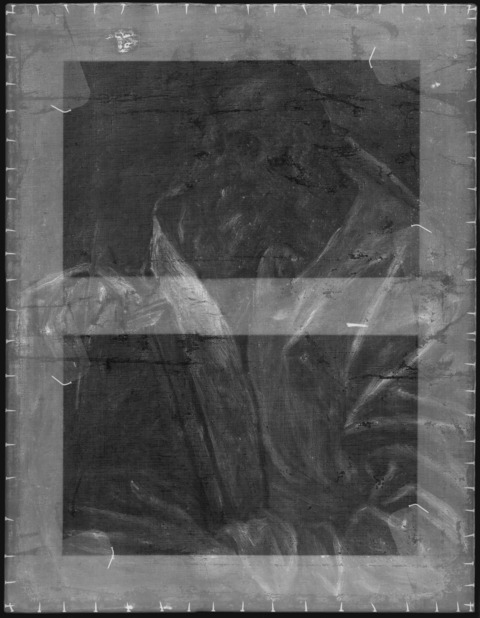
Material (fabric, wood, metal, dendrochronology results, fiber ID information, etc.):
The painting is executed on coarsely woven canvas that appears to be linen. The plain-weave canvas has a thread count of 11 × 11 threads/cm as discerned from the X-radiograph (tech. fig. 3).
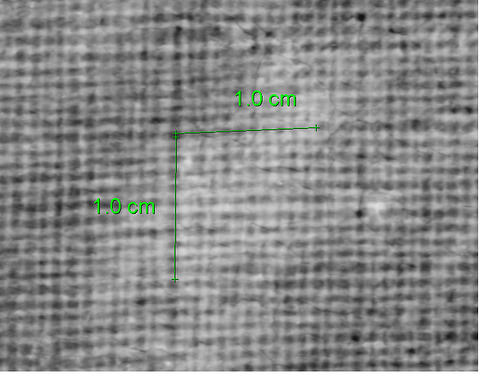
Characteristics of Construction / Fabrication (cusping, beveled edges of panels, seams, joins, battens):
No signs of cusping are visible (tech. fig. 2), and it appears that the painting was cut down at one point, probably at the time the painting was lined. The painting was likely not trimmed by much, as the size matches the portrait dimensions of the other two saints by El Greco in the Clowes Collection, and no elements appear to be missing in the composition. A stiff glue-paste lining, performed at the Prado before 1946, was applied to the canvas, and brown paper tape is present along all edges. This does not appear to have been the first time the painting was lined as it was referred to as a “relining."8
Thickness (for panels or boards):
N/A
Production/Dealer’s marks:
None
Attachment to Auxiliary Support:
In addition to tacks, the lining canvas was also glued to the stretcher. Brown paper tape is present along all edges.
Auxiliary Support:
Original Not original Not able to discern None
The auxiliary support is a relatively new five-member stretcher (one horizontal crossbar), with six keys and half laps at the joins. The edges are rounded, and the crossbar is slightly set back to prevent contact with the canvas. The crossbar is also rounded at the edges.
Condition of Support
The auxiliary support is in good condition with all six keys present and no signs of any major damage. A few nicks and dents from handling are present. The original canvas support was damaged along the edges, showing areas of loss as well as textured fills to imitate the canvas weave. Much of the original canvas is obscured by the lining canvas. The lining canvas appears to be in good condition. There are some stains on the back from the glue lining. A weave interference pattern is visible on the front of the painting from the application of the lining canvas.
Description of Ground
Analyzed Observed
Materials/Binding Medium:
The preparation layer is likely a gypsum and lead white-based ground.
Color:
The initial ground appears to be off-white, with a reddish brown imprimatura that was possibly created using a palette scrapings layer, as has been documented in other works from the El Greco workshop.9
Application:
Difficult to determine, but likely scraped over the surface of the canvas
Thickness:
Appears to be thinly applied
Sizing:
The canvas would likely have been sized prior to the application of the ground and paint layers.
Character and Appearance (Does texture of support remain detectable / prominent?):
The canvas texture remains prominent through the ground and paint layers.
Condition of Ground
The ground layer appears to be in good condition. There are some small losses throughout, as well as a few larger losses that were treated with red fill material during a previous restoration. The large losses include several horizontal ones in straight lines, consistent with a canvas that was once folded or rolled. This is particularly noticeable in the infrared reflectography image (tech. fig. 4).
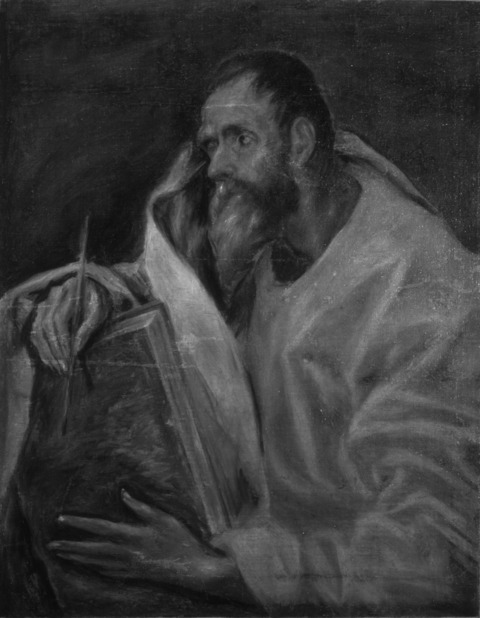
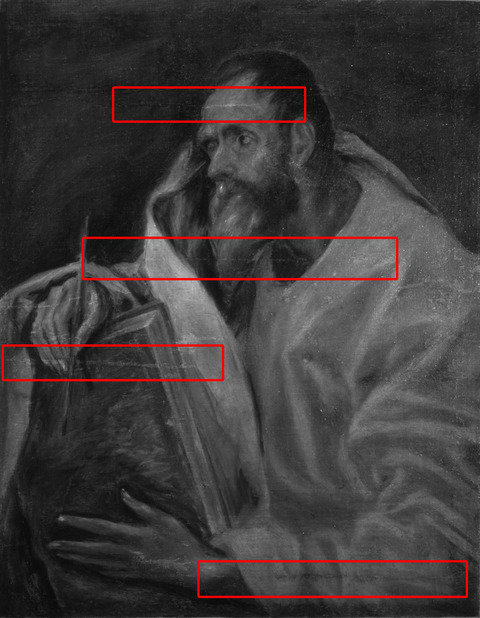
Description of Composition Planning
Methods of Analysis:
Surface observation (unaided or with magnification)
Infrared reflectography (IRR)
X-radiography
Analysis Parameters:
| X-radiography equipment | GE Inspection Technologies Type: ERESCO 200MFR 3.1, Tube S/N: MIR 201E 58-2812, EN 12543: 1.0mm, Filter: 0.8mm Be + 2mm Al |
|---|---|
| KV: | 20 |
| mA: | 3 |
| Exposure time (s) | 90 |
| Distance from X-ray tube: | 36″ |
| IRR equipment and wavelength | Opus Instruments Osiris A1 infrared camera with InGaAs array detector operating at a wavelength of 0.9–1.7µm. |

Medium/Technique:
No underdrawing is visible in the infrared reflectogram or to the naked eye. Some underpainting and adjustments are visible in the reflectogram in the form of dark, thick brushwork (tech. fig. 5) and slight variations of the hand (tech. fig. 6), beard, and folds in the clothing. This type of brushwork can also be seen in the upper paint layers, although there it is more subdued.
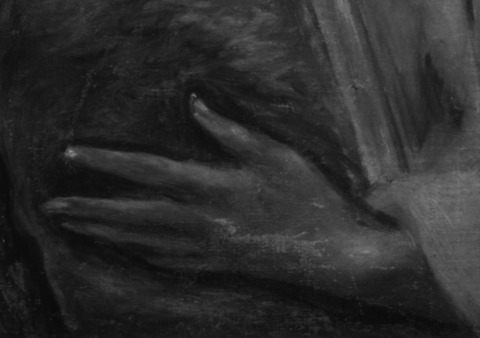
Pentimenti:
None apparent
Description of Paint
Analyzed Observed
Application and Technique:
The composition appears to have been delineated using loosely applied underpainting, followed by the upper layers of paint. As is the case in the St. Simon (2008.274) portrait, it appears that the background was applied first, followed by the drapery. Finally, the skin tones were painted. Unlike St. Simon, however, the edges where the areas meet are thoroughly overlapping and carefully blended, creating a more finished appearance than in the St. Simon. There are several areas where the reddish imprimatura is left to show through as gaps between swatches of color. A system of paint application seems to have been strictly followed, perhaps suggesting the painting is a product of a workshop. Final outlining in black is present around the hands, drapery, and features of the saint.
When viewed under the microscope, the paint surface and brushwork are indicative of both wet-in-wet and wet-over-dry techniques. This indicates that parts of the composition were allowed to dry before they were then repainted or modified.
Painting Tools:
Small brushes
Binding Media:
Oil (untested)
Color Palette:
The painting was created using a limited color palette composed primarily of iron oxide (earth pigments). XRF analysis identified major peaks for iron and lead in the brown background and brown book, suggesting the use of earth pigments mixed with lead white in these areas. Analysis in the hand identified a major peak for lead, suggesting the skin was painted using primarily lead white. Although not detected using XRF, it is likely that carbon black is also present in the palette. XRF analysis of the painting identified the robe’s bright green, the most vibrant color on the painting, as a copper-containing pigment, likely malachite or copper-resinate. It is also possible that this vibrant green is a mixture of azurite and a yellow ochre, as no tin was detected in this area (tech. fig. 7). The yellow part of robe contains lead and tin, suggesting the use of lead-tin yellow in this area.
XRF Analysis:
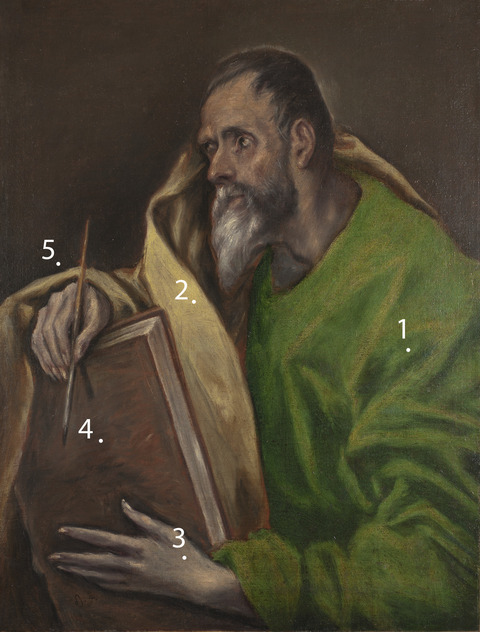
| Sample | Location | Elements | Possible Pigments |
|---|---|---|---|
| 1 | Green in proper left sleeve by shoulder | Major: Cu, Pb Minor: Ca, Fe Trace: Cr, Ni, K | Copper-containing blue and/or green pigment (likely malachite or copper resinate), lead white, iron oxide (earth pigments), calcium (from ground layer), trace of chromium (likely from retouching). |
| 2 | Yellow in robe | Major: Pb Minor: Ca Trace: Sn, Fe, Cu, Zn, Mn | Lead white, lead-tin yellow, calcium (from ground layer), iron oxide (earth pigments including umber), trace of copper-containing green and/or blue pigment, zinc white (likely from retouching) |
| 3 | Flesh tone in hand | Major: Pb Minor: Ca, Fe, Cu Trace: Zn, Mn, Ti | Lead white, iron oxide (earth pigments including umber), calcium (from ground layer), copper-containing green and/or blue pigment, zinc white (likely from retouching) |
| 4 | Brown in book | Major: Pb, Fe Minor: Ca Trace: Cu, K, Ti | Lead white, iron oxide (earth pigments), calcium (from ground layer), trace of copper-containing green and/or blue pigment. |
| 5 | Dark brown in background | Major: Pb, Fe Minor: Ca, Zn, Cu, Mn, Ti Trace: K | Lead white, iron oxide (earth pigments including umber), calcium (from ground layer), copper-containing green and/or blue pigment, zinc white (likely from retouching), possibly titanium white (from retouching). |
Table 1: Results of X-ray fluorescence analysis conducted with a Bruker Artax microfocus XRF with rhodium tube, silicon-drift detector, and polycapillary focusing lens (~100 μm spot).
*Major, minor, trace quantities are based on XRF signal strength not quantitative analysis
Surface Appearance:
The brushwork has definitive ridges and texture; some have worn away, possibly from prior cleaning campaigns, and others have been flattened from the lining process.
Condition of Paint
A micro-cracking pattern from natural aging extends over the entire painting. Small paint losses are scattered throughout the painting, as are some larger losses that have been subsequently retouched during a conservation campaign that was carried out before the painting arrived at the museum. General wear is visible around the perimeter of the painting where the paint is in contact with the frame. Embedded dirt is present throughout the painting. A horizontal cracking pattern is present and consistent with a canvas that has been rolled.
Description of Varnish/Surface Coating
Analyzed Observed Documented
| Type of Varnish | Application |
|---|---|
| Natural resin | Spray applied |
| Synthetic resin/other | Brush applied |
| Multiple Layers observed | Undetermined |
| No coating detected |
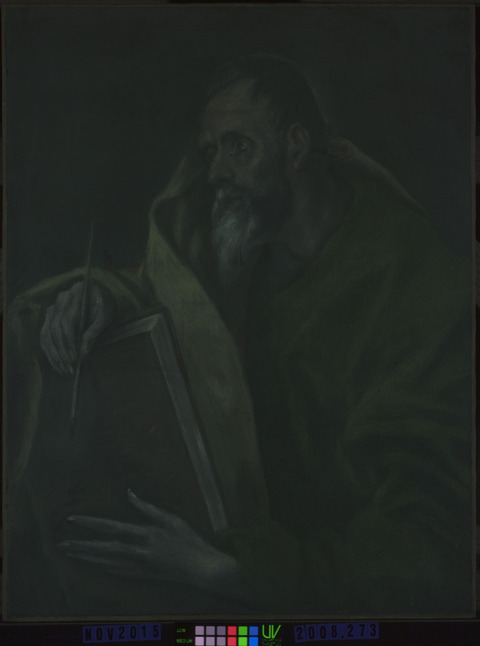
When imaged with ultraviolet-induced visible fluorescence, a characteristic green fluorescence is visible, indicating the presence of an aged natural resin varnish over the surface of the painting (tech. fig. 8). The painting also appears to have been sprayed with a synthetic varnish coating during an undocumented conservation campaign.
Condition of Varnish/Surface Coating
The natural resin varnish has discolored over time, imparting a slightly yellowed appearance to the painting. This is not too distracting, as much of the composition contains warm tones. A few small scuffs and minor losses are visible, particularly around the perimeter where the painting is in contact with the frame, but otherwise, the varnish is intact.
Description of Frame
Original/first frame
Period frame
Authenticity cannot be determined at this time/ further art historical research necessary
Reproduction frame (fabricated in the style of)
Replica frame (copy of an existing period frame)
Modern frame
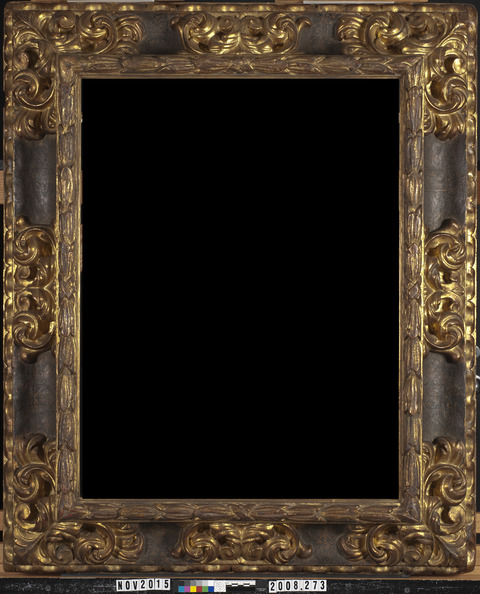
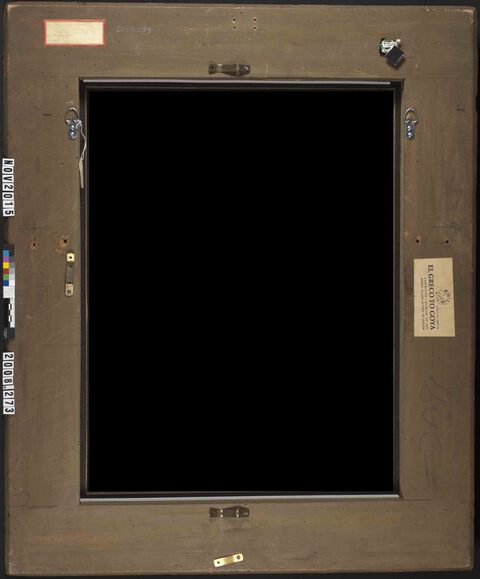
Frame Dimensions:
Outside frame dimensions: 98 × 81.5 × 8 cm
Sight size: 54 × 70.5 cm
Distinguishing Marks:
Item 2. Off-white exhibition label, back of left member: “April 20-May 26 El Greco to Goya Exhibition – Museum of Art Rhode Island School of Design” (tech. fig. 9).
Item 3. White label with red border, back of upper frame member: “The Clowes Fund Incorporated Fine Arts department 3744 Spring hollow Road Indianapolis 8 INDIANA USA No. 25 EL GRECO ST. LUKE” (tech. fig. 9).
Description of Molding/Profile:
The carved wooden frame has a painted and gilded surface (tech. fig. 8). The frame is similar to those on the other El Greco saints in the Clowes Collection, except for the designs on the black panels. Timothy Newbery described the stencil design on the painted black portions of this frame as having “overlapping squares."10
Condition of Frame
The frame is in relatively good condition.
Notes
-
Letter from Fernando Álvarez de Sotomayor to G.H.A. Clowes, 21 November 1952, Correspondence Files, Clowes Registration Archive, Indianapolis Museum of Art at Newfields. ↩︎
-
Letter from Edward O. Korany to B.M. Newhouse, 20 December 1952, Conservation Department Files, Indianapolis Museum of Art at Newfields. ↩︎
-
Letter from Bert Newhouse to G.H.A. Clowes, 9 June 1952, Correspondence Files, Clowes Registration Archive, Indianapolis Museum of Art at Newfields. ↩︎
-
Letter from Bert Newhouse to G.H.A. Clowes, 16 September 1952, Correspondence Files, Clowes Registration Archive, Indianapolis Museum of Art at Newfields. ↩︎
-
Letter from Clyde Newhouse to G.H.A. Clowes, 25 October 1952, Correspondence Files, Clowes Registration Archive, Indianapolis Museum of Art at Newfields. ↩︎
-
Paul A.J. Spheeris, “Conservation Report on the Condition of the Clowes Collection,” 25 October 1971, Conservation Department Files, Indianapolis Museum of Art at Newfields. ↩︎
-
Martin Radecki, Clowes Collection condition assessment, undated (after October 1971), Conservation Department Files, Indianapolis Museum of Art at Newfields. ↩︎
-
Letter from Fernando Álvarez de Sotomayor to G.H.A. Clowes, 21 November 1952, Correspondence Files, Clowes Registration Archive, Indianapolis Museum of Art at Newfields. ↩︎
-
“El Greco from Italy to Toledo: Technical Study of the Works in The Thyssen-Bornemisza Collection,” Museo Thyssen-Bornemisza website (2014), http://www2.museothyssen.org/microsites/exposiciones/2014/el-greco/evolucion-tecnica-pictorica-1.php?lang=en. ↩︎
-
Timothy Newbery, frame specialist, London, England. Visual analysis completed at the Indianapolis Museum of Art, 19 January 2012. ↩︎
Additional Images

